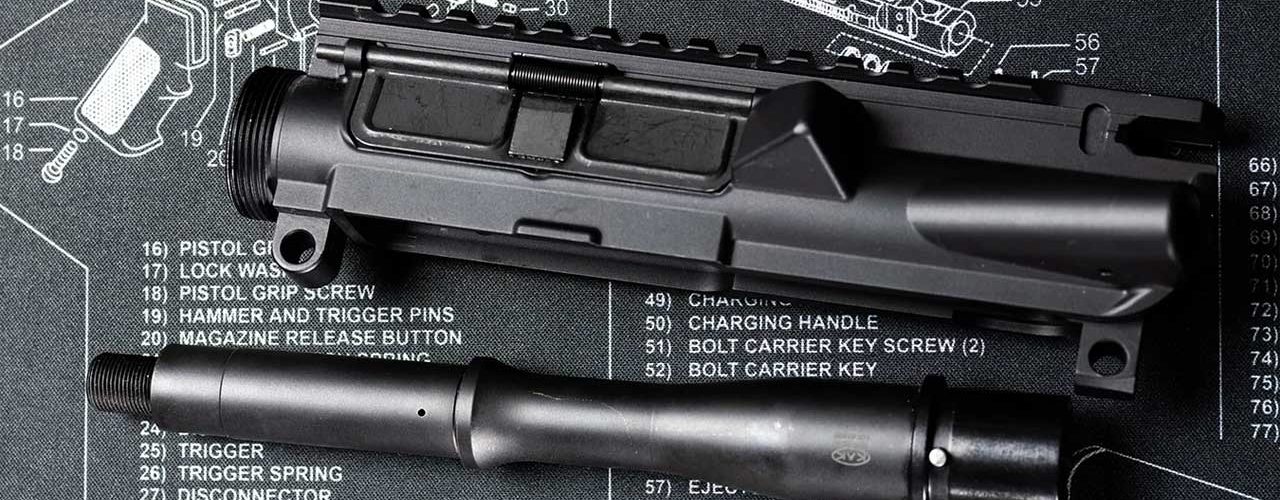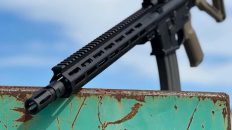The AR-15 upper receiver is a critical component of the popular rifle platform, and understanding its features and specifications is essential for gun enthusiasts and owners alike. In this comprehensive guide, we dive into the details of the AR-15 upper receiver and provide valuable insights to help you navigate the world of this versatile firearm.
From the materials used to the various types and configurations available, we explore every aspect of the AR-15 upper receiver. Whether you’re a seasoned shooter or new to the world of firearms, this guide will serve as your go-to resource for understanding the ins and outs of this vital component.
Discover the advantages of different upper receiver styles, such as the flat top and A2, and find out which one best suits your shooting preferences. Uncover crucial information on barrel length, gas systems, and handguard options, enabling you to customize your AR-15 to your specific needs.
With our comprehensive guide, you’ll gain a deeper understanding of the AR-15 upper receiver and enhance your overall shooting experience. Get ready to unlock the full potential of your firearm and make informed decisions when it comes to upgrading or selecting the right AR-15 upper receiver for your needs.
What is an AR-15 upper receiver?
The AR-15 upper receiver is the top half of the AR-15 rifle, housing the barrel, bolt carrier group, and other essential components. It is the part of the firearm that holds the barrel and attaches to the lower receiver, forming the complete rifle. The upper receiver is a crucial component that determines the overall performance, accuracy, and customization options of the AR-15 platform.
The upper receiver is responsible for containing the high-pressure gases generated during the firing process, guiding the bolt carrier group, and providing a stable platform for the barrel. It is a complex assembly that must be precisely engineered to ensure reliable and safe operation. Understanding the role and function of the AR-15 upper receiver is essential for anyone interested in building, customizing, or maintaining an AR-15 rifle.
Whether you’re a seasoned shooter or a newcomer to the world of AR-15s, this comprehensive guide will provide you with a deep understanding of the upper receiver and its various AR-15 parts. By the end of this article, you’ll have the knowledge to make informed decisions when it comes to selecting, upgrading, or maintaining the upper receiver of your AR-15 rifle.
The components of an AR-15 upper receiver
The AR-15 upper receiver is composed of several critical components that work together to ensure the proper functioning of the firearm. These components include the following:
- Barrel: The barrel is the tube through which the bullet travels after being fired. It is responsible for imparting spin and stabilization to the projectile, which affects accuracy and range.
- Gas system: The gas system is responsible for cycling the action of the rifle, allowing the bolt carrier group to move back and forth to eject the spent cartridge and load a new round.
- Bolt carrier group: The bolt carrier group is the heart of the AR-15 upper receiver, containing the bolt, carrier, and associated components that lock the action, fire the cartridge, and extract and eject the spent case.
- Charging handle: The charging handle is used to manually operate the bolt carrier group, allowing the user to chamber a round or clear a malfunction.
- Handguard: The handguard is the external component that surrounds the barrel, providing a secure and comfortable grip for the shooter.
- Sights or optics: Upper receivers can accommodate various sights, scopes, or other optical accessories to enhance the shooter’s aiming and target acquisition capabilities.
Understanding the function and interaction of these components is crucial for maintaining, troubleshooting, and customizing the AR-15 upper receiver. By familiarizing yourself with these key elements, you’ll be better equipped to make informed decisions when it comes to your firearm’s performance and configuration.
Different types of AR-15 upper receivers
The AR-15 platform offers a wide variety of upper receiver styles and configurations to suit the diverse needs and preferences of shooters. The most common types of AR-15 upper receivers include:
- Flat-top upper receivers: These upper receivers feature a flat top, allowing for the easy installation of various optics and sighting systems. Flat-top uppers are the most popular choice for modern AR-15 builds, as they provide a versatile and modular platform for customization.
- A2 upper receivers: The A2 upper receiver is characterized by its fixed carrying handle, which houses the rear sight. This design was used in the original M16A2 rifle and is still popular among some shooters who prefer the classic aesthetic and fixed sighting system.
- Removable carry handle upper receivers: These upper receivers feature a detachable carry handle, allowing the user to remove the handle and mount optics or sights directly on the flat-top receiver.
- Monolithic upper receivers: Monolithic upper receivers are machined from a single block of aluminum, integrating the handguard and barrel extension into a single, seamless unit. This design offers enhanced rigidity and a more streamlined appearance.
- Piston-driven upper receivers: Some AR-15 upper receivers are designed to use a gas piston system instead of the traditional direct impingement gas system. Piston-driven uppers offer reduced fouling and improved reliability in certain environments.
- Specialty upper receivers: Manufacturers also offer a variety of specialty upper receivers, such as those designed for short-barreled rifles (SBRs), suppressed configurations, or specific calibers like 6.5 Grendel or 300 Blackout.
Each type of upper receiver has its own advantages and disadvantages, so it’s important to carefully consider your intended use, shooting preferences, and customization goals when selecting the right upper receiver for your AR-15 build.
Understanding the barrel and barrel length for an AR-15 upper receiver
The barrel is a critical component of the AR-15 upper receiver, as it directly impacts the firearm’s accuracy, ballistics, and overall performance. When choosing an AR-15 upper receiver, the barrel length is a crucial factor to consider.
Barrel lengths for AR-15 rifles typically range from 7.5 inches to 24 inches, with the most common lengths being 16 inches, 18 inches, and 20 inches. The barrel length directly affects the velocity and trajectory of the bullet, as well as the overall weight and balance of the rifle.
Shorter barrels, such as those found in carbine-length or pistol-length uppers, offer increased maneuverability and are well-suited for close-quarters scenarios. However, they may sacrifice some velocity and long-range accuracy compared to longer barrels.
Conversely, longer barrels, like those found in rifle-length uppers, provide higher velocities and better long-range performance, but can be less maneuverable in tight spaces. Choosing the right barrel length for your needs is a matter of balancing factors such as intended use, personal preferences, and local laws and regulations.
In addition to barrel length, the AR-15 upper receiver can also be configured with different gas system lengths, which determine how the action is cycled. The most common gas system lengths are carbine, mid-length, and rifle-length, each with its own advantages and trade-offs in terms of recoil, reliability, and overall performance.
Understanding the impact of barrel length and gas system configuration on the AR-15 upper receiver will help you make an informed decision when selecting or upgrading your firearm to meet your specific shooting requirements.
Related: Read our article, Exploring the AR-15 Gas System: Everything You Need to Know, for more information on what is a gas system.
Choosing the right handguard for your AR-15 upper receiver
The handguard is an essential component of the AR-15 upper receiver, as it provides a secure and comfortable grip for the shooter. Handguards come in a variety of styles and materials, each offering unique features and benefits.
One of the primary considerations when selecting a handguard is the material. The most common materials used for AR-15 handguards include:
- Aluminum: Aluminum handguards are lightweight, durable, and widely popular among AR-15 owners. They offer a balance of strength, weight, and cost-effectiveness.
- Polymer: Polymer handguards are also a common choice, as they are lightweight and often more affordable than metal options. They can provide good thermal insulation and are available in a range of colors and patterns.
- Carbon fiber: Carbon fiber handguards are lightweight and offer excellent heat dissipation properties, making them a popular choice for high-performance builds. They are typically more expensive than aluminum or polymer options.
In addition to material, the handguard’s length and profile are also important factors to consider. Longer handguards offer more surface area for gripping and can provide additional support for accessories, such as lights or vertical foregrips. Shorter handguards, on the other hand, are more compact and maneuverable, making them well-suited for close-quarters scenarios.
The handguard’s profile can also vary, with options like round, quad-rail, or M-LOK/KeyMod systems. Each profile offers different attachment points for accessories and can affect the overall ergonomics and weight of the rifle.
When choosing a handguard for your AR-15 upper receiver, it’s essential to consider factors such as your intended use, personal preferences, and compatibility with your specific upper receiver and barrel configuration. Carefully selecting the right handguard can significantly enhance the comfort, functionality, and customization potential of your AR-15 rifle.
The importance of the bolt carrier group in an AR-15 upper receiver
The bolt carrier group (BCG) is the heart of the AR-15 upper receiver, responsible for the reliable cycling and firing of the rifle. This critical component houses the bolt, which locks the action and seals the chamber, and the carrier, which moves the bolt back and forth to extract and eject the spent cartridge and load a new round.
The design and materials used in the BCG can greatly impact the overall performance and reliability of the AR-15 rifle. High-quality BCGs are typically made from durable materials like steel or nickel-boron coated steel, ensuring long-term durability and consistent operation.
The bolt carrier group is responsible for several key functions within the AR-15 upper receiver:
- Locking the action: The bolt locks the action, sealing the chamber and containing the high-pressure gases generated during firing.
- Extraction and ejection: The BCG extracts the spent cartridge case and ejects it from the rifle, making way for the next round to be loaded.
- Feeding and chambering: The BCG feeds a new cartridge from the magazine and chambers it, readying the rifle for the next shot.
- Gas system operation: Depending on the gas system configuration, the BCG either directly uses the high-pressure gases to cycle the action (direct impingement) or is operated by a piston system.
Choosing the right bolt carrier group for your AR-15 upper receiver is crucial, as it can affect the rifle’s reliability, accuracy, and overall performance. Factors such as material, coating, and gas system compatibility should be carefully considered when selecting a BCG.
Whether you’re building a custom AR-15 or maintaining an existing one, understanding the importance of the bolt carrier group and its role within the upper receiver will help you make informed decisions and ensure the optimal performance of your firearm.
Optics and sights for an AR-15 upper receiver
The AR-15 upper receiver is designed to accommodate a wide variety of optics and sighting systems, allowing shooters to customize their firearms to suit their specific needs and preferences. From traditional iron sights to advanced red dot sights and magnified scopes, the options for AR-15 upper receiver optics are vast and diverse.
One of the primary advantages of the AR-15 platform is its modularity, which extends to the optics and sighting systems. The flat-top upper receiver design, in particular, provides a versatile mounting platform for a variety of optics and accessories.
Some of the most popular optics and sighting systems for the AR-15 upper receiver include:
- Iron sights: Traditional iron sights, such as the A2 front sight and removable carry handle rear sight, provide a reliable and affordable sighting solution for the AR-15.
- Red dot sights: Compact, battery-powered red dot sights offer fast target acquisition and both-eyes-open shooting, making them a popular choice for close to medium-range engagements.
- Holographic sights: Holographic sights, such as the EOTech, project a reticle image onto a transparent display, providing a wide field of view and rapid target acquisition.
- Magnified optics: Rifle scopes with variable magnification can be mounted on the AR-15 upper receiver, allowing for precise long-range shooting and increased accuracy.
- Reflex sights: Reflex sights, like the Aimpoint Micro, are compact, lightweight, and offer a quick-acquisition aiming point, making them well-suited for fast-paced shooting scenarios.
When selecting optics and sights for your AR-15 upper receiver, it’s essential to consider factors such as your intended use, shooting environment, and personal preferences. Carefully researching and testing different options can help you find the perfect sighting solution to maximize the performance of your AR-15 rifle.
Customizing and upgrading your AR-15 upper receiver
One of the most appealing aspects of the AR-15 platform is its exceptional customization potential, and the upper receiver is a prime area for upgrades and modifications. Whether you’re looking to enhance the performance, aesthetics, or functionality of your AR-15, there are countless options available for customizing the upper receiver.
Some of the most popular AR-15 upper receiver customization and upgrade options include:
- Barrel upgrades: Swapping out the barrel for a higher-quality or specialized version can improve accuracy, velocity, and overall performance.
- Handguard replacement: Upgrading the handguard can enhance ergonomics, weight, and the ability to mount accessories.
- Bolt carrier group upgrades: Investing in a high-quality, properly coated BCG can improve reliability and durability.
- Muzzle devices: Adding a muzzle brake, suppressor, or other muzzle device can help manage recoil, reduce muzzle rise, or accommodate a suppressor.
- Optics and sighting systems: Upgrading the optics or sights can significantly improve target acquisition and shooting precision.
- Aesthetic customization: Changing the upper receiver’s finish, color, or other visual elements can personalize the appearance of your AR-15.
When customizing or upgrading your AR-15 upper receiver, it’s essential to ensure compatibility with your existing lower receiver and other components. Consulting with knowledgeable gunsmiths or researching extensively online can help you make informed decisions and avoid any potential issues.
By carefully selecting and installing the right upgrades for your AR-15 upper receiver, you can tailor your firearm to perfectly suit your shooting needs and preferences, unlocking its full potential and enhancing your overall experience.
Cleaning and maintenance tips for an AR-15 upper receiver
Proper cleaning and maintenance of the AR-15 upper receiver is crucial for ensuring the reliable and safe operation of your firearm. Regular care and attention to the upper receiver’s components can extend the lifespan of your rifle and help prevent malfunctions or other issues.
Here are some essential cleaning and maintenance tips for the AR-15 upper receiver:
- Disassembly: Begin by thoroughly disassembling the upper receiver, removing the bolt carrier group, charging handle, and any other removable components.
- Cleaning the barrel: Use a bore brush, cleaning rod, and appropriate solvents to thoroughly clean the barrel’s interior, removing any carbon buildup or fouling.
- Cleaning the bolt carrier group: Carefully clean all the surfaces of the bolt, carrier, and associated components, ensuring they are free of debris and residue.
- Cleaning the gas system: Pay close attention to the gas tube and gas block, using cleaning rods and solvents to remove any accumulated carbon or fouling.
- Cleaning the handguard and upper receiver: Wipe down the exterior of the upper receiver and handguard, removing any dirt, dust, or fingerprints.
- Lubrication: After cleaning, apply a thin, even layer of high-quality gun lubricant to all the moving parts and contact surfaces within the upper receiver.
- Inspection: Carefully inspect all components for any signs of wear, damage, or unusual wear patterns, and replace any parts as necessary.
- Reassembly: Carefully reassemble the upper receiver, ensuring all components are properly aligned and functioning correctly.
Regularly following these cleaning and maintenance steps will help ensure the long-term reliability and performance of your AR-15 upper receiver. Additionally, it’s essential to consult the manufacturer’s recommendations and guidelines for any specific cleaning or maintenance requirements for your particular upper receiver model.
By dedicating time and attention to the care of your AR-15 upper receiver, you’ll be able to enjoy the full capabilities of your firearm for years to come.
Conclusion
The AR-15 upper receiver is a critical component of the popular rifle platform, and understanding its features, specifications, and customization options is essential for gun enthusiasts and owners alike. In this comprehensive guide, we have explored the various aspects of the AR-15 upper receiver, from its core components to the different types and configurations available.
We have dived into the importance of the barrel length, gas system, and handguard, as well as the crucial role of the bolt carrier group in the overall performance and reliability of the firearm. Additionally, we have discussed the wide range of optics and sighting systems that can be integrated into the AR-15 upper receiver, allowing shooters to tailor their rifles to their specific needs and preferences.
Furthermore, we have examined the vast potential for customization and upgrading of the AR-15 upper receiver, highlighting the various options available for enhancing the firearm’s accuracy, functionality, and aesthetics. Finally, we have provided valuable insights into the proper cleaning and maintenance of the upper receiver, ensuring the long-term performance and safety of your AR-15 rifle.
Whether you are a seasoned shooter or new to the world of firearms, this comprehensive guide has provided you with the knowledge and understanding necessary to make informed decisions when it comes to selecting, upgrading, or maintaining the AR-15 upper receiver. By mastering the intricacies of this vital component, you’ll be well on your way to unlocking the full potential of your AR-15 rifle and elevating your shooting experience to new heights.





Add comment